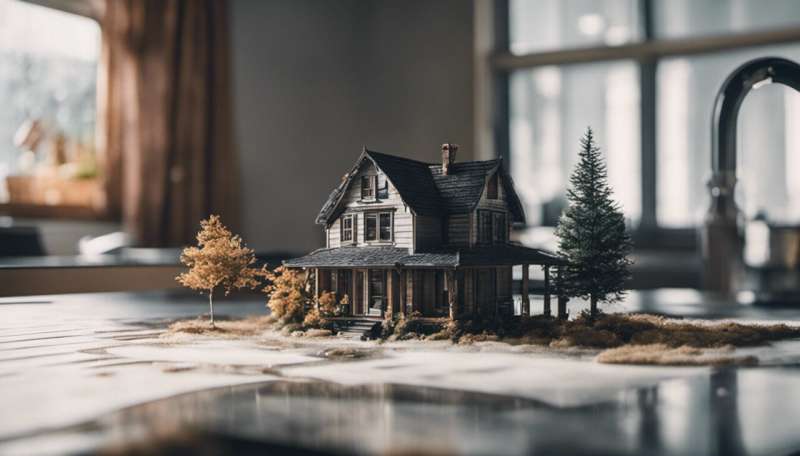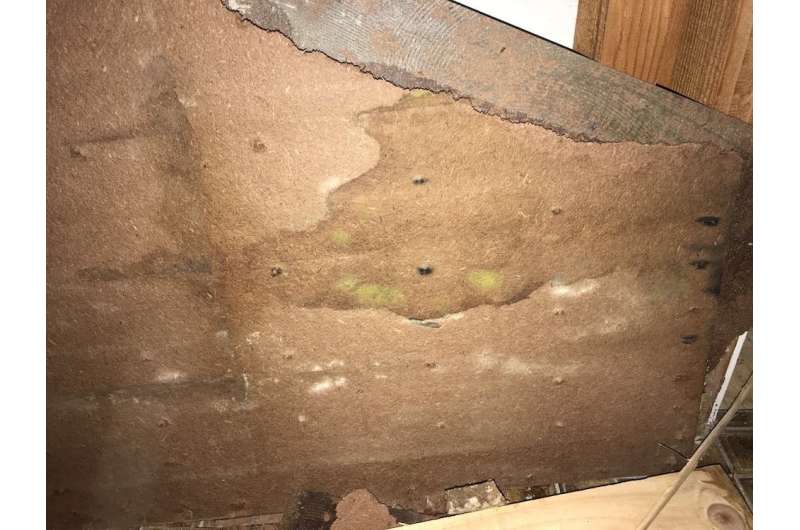This article has been reviewed according to Science X's editorial process and policies. Editors have highlighted the following attributes while ensuring the content's credibility:
fact-checked
trusted source
written by researcher(s)
proofread
What do the different colors of mold mean in my house?

You may be interested (or possibly horrified) to discover you ingest and inhale thousands of tiny life forms on a daily basis.
The air and surfaces around you are home to multitudes of bacteria, fungi, viruses, mites, algae and protozoa. Your skin isn't much better, with a complex ecosystem of organisms called commensals which aren't necessarily good or bad, but will shift in their composition depending on where you live, the products you use and the pets you have.
Most of these creatures are generally undetectable due to their microscopic size and low concentrations. But when they find a niche they can exploit, you might notice them by their smell, or the appearance of unwanted staining and color changes. A lot of this fungal growth is what we call mold.
We've all been disappointed in ourselves at one time or another, lifting a neglected orange out of the fruit bowl to discover the bottom half is covered in a velvety blue-green growth.
But what do the myriad colors that appear on our stuff tell us about the world we try not to think about?
Black
Often black staining is quite a disturbing occurrence. The concept of toxic black mold is one many people have become aware of due to flood impacts.
A quick online search will likely terrify you, but not all black discolouration is due to the same organisms, and almost none of it will outright cause you harm.
Stachybotrys is the one known as toxic black mold. It often turns up on building materials that have been wet for a long time.
When the grout in your shower turns black though, that's a different fungus called Aureobasidium. It's slimy, sticky and somewhere between a filamentous mold, which grows threadlike roots through whatever it's eating, and a yeast, which prefer a free-floating, single-celled style of life.
Bleaching will often kill Aureobasidium, but the dark pigmentation will likely hang around—harmlessly, but stubbornly.

Blue
That blue orange I mentioned before, you can thank Penicillium for that. The organism that gives us blue cheese and the antibiotic penicillin is also responsible for producing a dense growth of mold that almost looks like smoke when disturbed, spreading millions of spores onto the rest of your fruit bowl.
Penicillium is a big group with hundreds of species, ranging from recognized pathogens to species yet to be named. However, the ones that turn up in our homes are generally the same "weed" species that simply cause food spoilage or grow in soil.
Yellow and orange
We often think of fungi as organisms that thrive in the dark, but that's not always true. In fact, some need exposure to light—and ultraviolet (UV) light in particular—to complete their life cycle.
Many plant pathogens use UV light exposure as a trigger to produce their spores, and then protect their DNA by hiding it behind melanin-containing shells.
Stemphylium and Epicoccum turn up in our homes from time to time, often hitching a ride on natural fibers such as jute, hemp and hessian. They produce a spectrum of staining that can often turn damp items yellow, brown or orange.
Green
We're all fairly familiar with the green spots that turn up on moldy bread, cake and other food items. Often we try to convince ourselves if we just cut off the bad bit, we can still salvage lunch.
Sadly that's not the case, as the roots of the fungi—collectively called mycelium—spread through the food, digesting and collecting sufficient nutrients to pop out a series of tiny fruiting bodies which produce the colored spores you see.
The green tuft is often from a group of fungi called Aspergillus. Under the microscope they look rather like the puffy top of a dandelion gone to seed.

Like Penicillium, Aspergillus is another big fungal group with lots of species that turn up virtually in every environment. Some are heat tolerant, some love acid and some will happily produce spores that stay airborne for days to months at a time.
In the green gang is also a fungus called Trichoderma, which is Latin for "hairy skin". Trichoderma produces masses of forest-green, spherical spores which tend to grow on wet cardboard or dirty carpet.
Pink, purple and red
There are plenty to speak of in this category. And there is also a common bacterium that makes the list.
Neurospora, also known as the red bread mold, is one of the most studied fungi in scientific literature. It's another common, non-hazardous one that has been used as a model organism to observe fungal genetics, evolution and growth.
Fusarium is less common indoors, being an important crop pathogen, but will sometimes turn spoiled rice purple. It also occasionally turns up on wet cement sheet, causing splotchy violet patches. Fusarium makes large, sticky, moon-shaped spores that have evolved to spread by rain splashes and hang onto plants. However, it is fairly bad at getting airborne and so doesn't tend to spread very far from where it's growing.
Finally in this category, that pink scum that turns up around bathroom taps or in the shower? It's actually a bacterium called Serratia. It will happily chew up the soap scum residue left over in bathrooms, and has been shown to survive in liquid soaps and handwash.
White
When fungi were first being classified and were eventually given their own phylogenetic kingdom, there were lots of wonderful and not strictly categorical ways we tried to split them up. One of these was hyaline and non-hyaline, essentially referring to transparent and colored, respectively.
One of the interesting non-pigmented molds you may well catch sight of is a thing called Isaria farinosa ("farinosa" being Latin for "floury"). This fungus is a parasite of some moths and cicadas and is visible as brilliant white, tree-shaped growths on their unfortunate hosts.
So when you notice the world around you changing color, you can marvel with your newfound knowledge at the microscopic wonders that live complex lives alongside yours. Then maybe clean it up, and give the fruit bowl a wash.
Provided by The Conversation
This article is republished from The Conversation under a Creative Commons license. Read the original article.![]()


















